fromport
Solar Addict
Great!After about 6 weeks of confusion and going around in circles, I finally ordered two hybrid inverters.
Did you also get some batteries?
Great!After about 6 weeks of confusion and going around in circles, I finally ordered two hybrid inverters.
I've had $35000 heart monitors fail on me when I needed a most in my main job when it comes to something complicated and mechanical I always want a backup... If this was true off grid I would just have 2 cheaper inverters But There are 2 things 1 it's a brand new productAnd if it breaks and replacement is 5 to 10 days away... But I also don't want to spend $2000 coming up with a disconnect system... Then it begins defeating the purposeIt comes down to....do you trust this inverter or not ?
IF it is made with the exact same quality and QA as the Sol-arks then yes, trust it.
If not, prepare a quick and easy method to go around it if it blows up.
I generally agree, but it is nice to be able to work on the inverter or swap it out without taking the house offline. This is even more important when your service goes straight to the inverter and then to the only distribution panel.It comes down to....do you trust this inverter or not ?
IF it is made with the exact same quality and QA as the Sol-arks then yes, trust it.
If not, prepare a quick and easy method to go around it if it blows up.
Cost of what I showed above is under $500 if you go with the switch. A Square D 225A external panel costs around $110 from Gordon Electric. Two matching 100A two-pole breakers cost $64 each from HomeDepot, and a 100A Eaton double-pole double-throw switch costs $222 from HomeDepot. #1 copper stranded cable costs no more than $4 a foot. Aluminum is less expensive of course.I've had $35000 heart monitors fail on me when I needed a most in my main job when it comes to something complicated and mechanical I always want a backup... If this was true off grid I would just have 2 cheaper inverters But There are 2 things 1 it's a brand new productAnd if it breaks and replacement is 5 to 10 days away... But I also don't want to spend $2000 coming up with a disconnect system... Then it begins defeating the purpose
Im 200amp serviceCost of what I showed above is under $500 if you go with the switch. A Square D 225A external panel costs around $110 from Gordon Electric. Two matching 100A two-pole breakers cost $64 each from HomeDepot, and a 100A Eaton double-pole double-throw switch costs $222 from HomeDepot. #1 copper stranded cable costs no more than $4 a foot. Aluminum is less expensive of course.
Are you sure? Do you really use 200A? Do you have double-pole 100A breaker, two double-pole 100A breakers, or a quad pole 200A breaker? If the grid fails you are only going to get 50A out of the inverter, and only 100A out of two of them. If you really use 200A then your cost will be high. Your house must be large or you must be talking about your business. In either case, you can probably afford it and an electrician to install it. If that isn't the case, then I would plan on having a long 4/0 cable ready to rewire your meter to your load center in the event of an inverter failure.Im 200amp service
Im 200amp service
My service is 200 amps but my back up generator is 6500watts 240 volts and runs about everything I need unless my 4 freezers and electric watter heater go on at same time in an emergency outage... But because my main is 200 amp Im assuming I need 200 amp breaker...Are you sure? Do you really use 200A? Do you have double-pole 100A breaker, two double-pole 100A breakers, or a quad pole 200A breaker? If the grid fails you are only going to get 50A out of the inverter, and only 100A out of two of them. If you really use 200A then your cost will be high. Your house must be large or you must be talking about your business. In either case, you can probably afford it and an electrician to install it. If that isn't the case, then I would plan on having a long 4/0 cable ready to rewire your meter to your load center in the event of an inverter failure.
No batteries, I decided not to AC couple. Once the hybrid inverters are able to provide me emergency power in the sun, I will add (2) 10 KW 200AH power wall batteries. If all is good, I will add another (2) 10 KW 200AH power wall batteries for a total 800AH. I'm not living off-grid, so the batteries are for short power outages and to have some emergency power for necessities should there ever be a major event.Great!
Did you also get some batteries?
Congrats on the purchase!If I use SA-15K, I would need to cheat in order to use 9 solar panels with VOC of 429VDC (over limit 425VDC)
A heavy 94 Lbs package arrived today.Mine should arrive today. I am looking forward to install it and play with it over the weekend


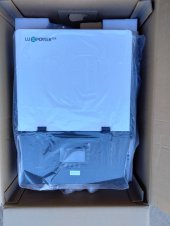

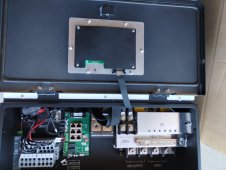

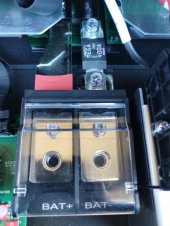
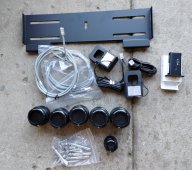
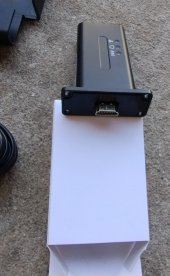
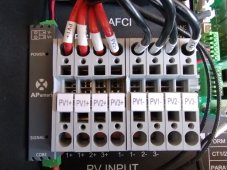
Some inverters don't support battery-less operation with inverters in parallel. I hope that is not the case with this inverter, but you may find that you are required to have a battery to parallel the inverters. Also I think you must have the wifi dongle in order to configure the inverters in parallel. Make sure you are getting the dongles and everything you need to parallel them. The manual also says that you will need a customer ID for the monitoring software, and that they must create one for you.No batteries, I decided not to AC couple. Once the hybrid inverters are able to provide me emergency power in the sun, I will add (2) 10 KW 200AH power wall batteries. If all is good, I will add another (2) 10 KW 200AH power wall batteries for a total 800AH. I'm not living off-grid, so the batteries are for short power outages and to have some emergency power for necessities should there ever be a major event.
With 2 inverters, I have 8 strings, which will permit me to use the MPPT connections for my existing 57 solar panels and add another future 23 panels. I can put 10 solar panels on a string with an adjusted VOC of 477VDC (under limit 500VDC) with the GSL-12K. For now, I will use the existing 18,810W of solar panels and add 7590W later.
Right or Wrong, I have reasons for my madness.
Exciting! Very nice. The WiFi connector looks like HDMI. Did you have to ask for the dongle or did it come with the inverter?Close up of the WIFI dongle.
The plug looks a lot like a DVI connector
View attachment 117302
To my surprise it comes with a built in RSD transmitter (on the left)!
I also think that it would be better to have at least 1 (small) battery (_with_ BMS communication) to at least 1 of the inverters to act as a buffer.Some inverters don't support battery-less operation with inverters in parallel. I hope that is not the case with this inverter, but you may find that you are required to have a battery to parallel the inverters.
Afaik wifi dongle is only used for monitoring to the cloud so you can see statistic. Communication between the inverters is done with a shielded RJ45 cable.Also I think you must have the wifi dongle in order to configure the inverters in parallel.
Will be able to tell you more in a few days ;-)Settings for paralleling function in monitor system 1. Set up monitoring for the system, add all dongles into one station. Users can login to visit the monitor system, Configuration->Station->Plant Management->Add dongle to add dongles.
Users can use WiFi/ WLAN /4G /2G dongle to monitor their inverter, and view the monitoring data on computer or smart phone remotely. To view data on smartphone, please download the LuxPowerView APP from Google Play or Apple APP store, then login with their user account.
The "customer code" is a code we assigned to your distributor or installer. You can contact your supplier for their code.
I agree with what you said.Congrats on the purchase!
BTW, I believe the SA 15K has a max VOC of 500VDC @ 26A, IIRC.
The sticker on my LuxPower says 120-500V MPPT rangethe MPPT operating voltage range 255VDC to 500VDC for the GSL-12K.
Same on the LuxPower ;-)GSL list their maximum input voltage at 600VDC.
From what I read in the manual you have to connect to the software in order to form a parallel group. Those screens aren't in the LCD and are too large for it.Afaik wifi dongle is only used for monitoring to the cloud so you can see statistic. Communication between the inverters is done with a shielded RJ45 cable.
Will be able to tell you more in a few days ;-)
3 MPPT controllers 100-600V (230-500V for MPPTs) (4 strings total - 2/1/1, 25A/15A/15A, 12kW/7kW/7kW)The sticker on my LuxPower says 120-500V MPPT range
Same on the LuxPower ;-)
Can you open the top part of the inverter and take some pictures of the insides? I would like to see the motherboard and the inductors, etc.Will be able to tell you more in a few days ;-)
I bet you the configuration might be way easier to do using app/desktop.From what I read in the manual you have to connect to the software in order to form a parallel group. Those screens aren't in the LCD and are too large for it.
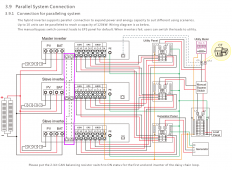
I agree that it looks good. It surpasses my expectations so far.Thanks for providing all of the images. More confirmation that its a LuxPower branded inverter. The GSL branding is supposed to be available in a couple of weeks. Please keep us informed as you learn from it. It looks like a great alternative so far.
I agree, I investigate a couple inverters that specified that scenario. The Solar MPP and the SunGoldPower hybrid inverters are battery-less for a single inverter. However, when you parallel them, they require batteries for every inverter in parallel. I had consider them, until I read in their user manual that a 40A disconnect is required between the inverter and the grid. I think you needed to buy 3 inverters and 6 batteries just to have 125A available on-grid or off-grid. These hybrid inverters didn't have the 200A pass-through current like other models.Some inverters don't support battery-less operation with inverters in parallel. I hope that is not the case with this inverter, but you may find that you are required to have a battery to parallel the inverters. Also I think you must have the wifi dongle in order to configure the inverters in parallel. Make sure you are getting the dongles and everything you need to parallel them. The manual also says that you will need a customer ID for the monitoring software, and that they must create one for you.
Settings for paralleling function in monitor system 1. Set up monitoring for the system, add all dongles into one station. Users can login to visit the monitor system, Configuration->Station->Plant Management->Add dongle to add dongles.
Users can use WiFi/ WLAN /4G /2G dongle to monitor their inverter, and view the monitoring data on computer or smart phone remotely. To view data on smartphone, please download the LuxPowerView APP from Google Play or Apple APP store, then login with their user account.
The "customer code" is a code we assigned to your distributor or installer. You can contact your supplier for their code.


